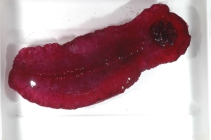WoRMS taxon details
Holothuroidea
Holothurioidea · unaccepted (Spelling variation?)
Holothuroides · unaccepted (name change not accepted by...)
name change not accepted by scientific community
- Subclass Actinopoda
- Subclass Paractinopoda
- Subclass Actinota accepted as Actinopoda
- Subclass Dendrochirotacea accepted as Actinopoda (All recent evidence indicates this is not a subclass)
- Subclass Elpidiacea accepted as Actinopoda
- Subclass Holothuriacea accepted as Actinopoda
- Subclass Paractinota accepted as Paractinopoda
- Subclass Synaptacea accepted as Paractinopoda
- Subclass Actinopoda incertae sedis (temporary name)
- Subclass Holothuroidea incertae sedis (temporary name)
marine, brackish, fresh, terrestrial
recent + fossil
Blainville, H. M. D. de. (1834). Manuel d'actinologie ou de zoophytologie. <em>F.G. Levroult. Paris: Strasbourg.</em> 1-2: 1-644, pls. I-C., available online at https://www.biodiversitylibrary.org/page/9680581
page(s): 188 [details]
page(s): 188 [details]
WoRMS (2025). Holothuroidea. Accessed at: https://www.marinespecies.org/aphia.php?p=taxdetails&id=123083 on 2025-07-12
Date
action
by
![]() The webpage text is licensed under a Creative Commons
Attribution 4.0 License
The webpage text is licensed under a Creative Commons
Attribution 4.0 License
Nomenclature
original description
Blainville, H. M. D. de. (1834). Manuel d'actinologie ou de zoophytologie. <em>F.G. Levroult. Paris: Strasbourg.</em> 1-2: 1-644, pls. I-C., available online at https://www.biodiversitylibrary.org/page/9680581
page(s): 188 [details]
original description (of Holothuroides) Telford, M.; Mooi, R. (1986). Echinoderms, Babel and the Confusion of Nomenclature. <em>Systematic Biology.</em> 35(2): 254-255., available online at https://doi.org/10.1093/sysbio/35.2.254
page(s): 255 [details]
basis of record Hansson, H.G. (2001). Echinodermata, <B><I>in</I></B>: Costello, M.J. <i>et al.</i> (Ed.) (2001). <i>European register of marine species: a check-list of the marine species in Europe and a bibliography of guides to their identification. Collection Patrimoines Naturels,</i>. 50: pp. 336-351. (look up in IMIS) [details]
page(s): 188 [details]
original description (of Holothuroides) Telford, M.; Mooi, R. (1986). Echinoderms, Babel and the Confusion of Nomenclature. <em>Systematic Biology.</em> 35(2): 254-255., available online at https://doi.org/10.1093/sysbio/35.2.254
page(s): 255 [details]
basis of record Hansson, H.G. (2001). Echinodermata, <B><I>in</I></B>: Costello, M.J. <i>et al.</i> (Ed.) (2001). <i>European register of marine species: a check-list of the marine species in Europe and a bibliography of guides to their identification. Collection Patrimoines Naturels,</i>. 50: pp. 336-351. (look up in IMIS) [details]
Identification resource
identification resource
Purcell, S.W., Samyn, Y. & Conand, C. (2013). Commercially important sea cucumbers of the world. FAO Species Catalogue for Fishery Purposes. No. 6. Rome, FAO. 2012. 150 pp. 30 colour plates, available online at http://www.fao.org/docrep/017/i1918e/i1918e.pdf [details]
Other
context source (PeRMS)
Solís-Marín, F. A.; Alvarado, J. J.; Abreu-Pérez, M.; Aguilera, O.; Alió, J.; Bacallado-Aránega, J. J.; Barraza, E.; Benavides-Serrato, M.; Benítez-Villalobos, F.; Betancourt-Fernández, L.; Borges, M.; Brandt, M.; Brogger, M. I.; Borrero-Pérez, G. H.; Buitrón-Sánchez, E.; Campos, L. S.; Cantera, J.; Clemente, S.; Cohen-Renjifo, M.; Coppard, S.; Costa-Lotufo, L. V.; del Valle-García, R.; Díaz, Y.; Díaz de Vivar, M. E.; Díaz-Martínez, J. P.; Durán-González, A.; Epherra, L.; Escolar, M.; Francisco, V.; Freire, C. A.; García-Arrarás, E.; Gil, D. G.; Guarderas, P.; Hadel, V. F.; Hearn, A.; Hernández, J. C.; Hernández-Delgado, E. A.; Herrera-Moreno, A.; Herrero-Pérezrul, M. D.; Hooker, Y.; Honey-Escandón, M. B. I.; Lodeiros, C.; Luzuriaga, M.; Manso, C. L. C.; Martín, A.; Martinez, M. I.; Martínez, S.; Moro-Abad; Mutschke, E.; Navarro, J. C.; Neira, R.; Noriega, N.; Palleiro-Nayar, J. S.; Pérez, A. F.; Pérez-Ruzafa, A.; Prieto-Rios, E.; Reyes, J.; Rodríguez, R.; Rubilar, T.; Sancho-Mejía, T.; Sangil, C.; Silva, J. R. M. C.; Sonnenholzner, J. I.; Ventura, C. R.; Tablado, A.; Tavares, Y.; Tiago, C. G.; Tuya, F.;Williams, S. M. (2013). Appendix. <em>In: J. J. Alvarado & F. A. Solís-Marín (eds), Echinoderm Research and Diversity in Latin America.</em> pp. 471-510. Springer; Berlin & Heidelberg. page(s): 543-654. [details]
additional source Reich, M. (2015). Supplement 2 to “How many species of fossil holothurians are there?”. <em>Zitteliana A.</em> 55: 121-122., available online at https://doi.org/10.5282/ubm/epub.26939 [details] Available for editors [request]
[request]
additional source Reich, M. (2014). Supplement to: 'How many species of fossil holothurians are there ?'. <em>Göttingen Contributions to Geosciences.</em> 77: 161-162., available online at https://doi.org/10.3249/webdoc-3926 [details] Available for editors [request]
[request]
additional source Reich, M. (2013). How many species of fossil holothurians are there ? In: Johnson, C., ed.: <em>Echinoderms in a Changing World</em>. pp. 23-51; Boca Raton / London / New York / Leiden (CRC Press, Taylor & Francis Group)., available online at https://doi.org/10.1201/b13769-5 [details] Available for editors [request]
[request]
additional source Reich, M. (2015). Supplement 2 to “How many species of fossil holothurians are there?”. <em>Zitteliana A.</em> 55: 121-122., available online at https://doi.org/10.5282/ubm/epub.26939 [details] Available for editors
additional source Reich, M. (2014). Supplement to: 'How many species of fossil holothurians are there ?'. <em>Göttingen Contributions to Geosciences.</em> 77: 161-162., available online at https://doi.org/10.3249/webdoc-3926 [details] Available for editors
additional source Reich, M. (2013). How many species of fossil holothurians are there ? In: Johnson, C., ed.: <em>Echinoderms in a Changing World</em>. pp. 23-51; Boca Raton / London / New York / Leiden (CRC Press, Taylor & Francis Group)., available online at https://doi.org/10.1201/b13769-5 [details] Available for editors
 Present
Present  Inaccurate
Inaccurate  Introduced: alien
Introduced: alien  Containing type locality
Containing type locality
From editor or global species database
Spelling Original spelling: Holothuridea (emended by E. P. Wright 1868, p. 652) [details]
| Language | Name | |
|---|---|---|
| Dutch | zeekomkommers | [details] |
| English | sea cucumbers | [details] |
| Japanese | ナマコ/海鼠綱 | [details] |
| Swedish | sjögurkor | [details] |


